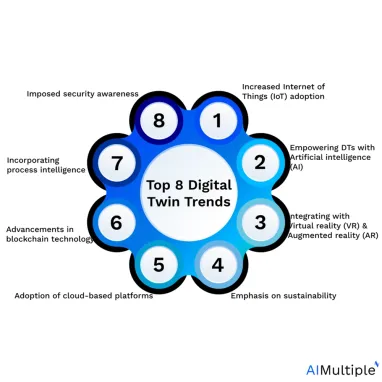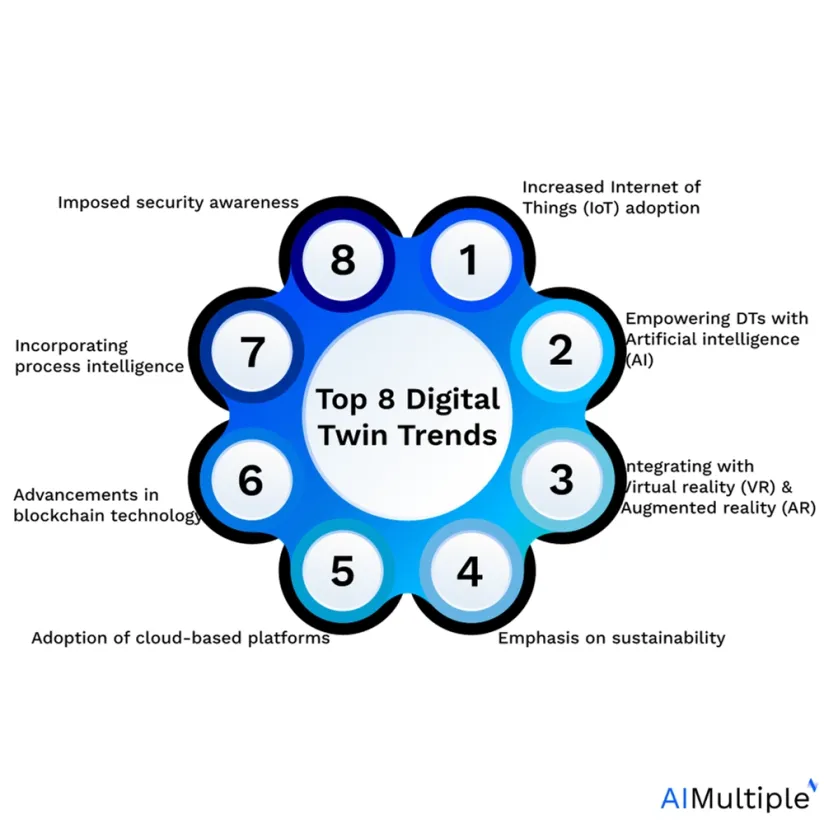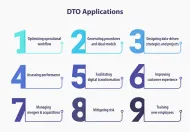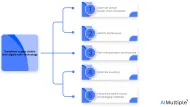Discover Top 8 Digital Twin Trends in 2024


The digital twins market is estimated to grow 71% in two years.1 Digital twins are applicable to various industries, such as:
The latest developments in digital twin technology point out potential increase in the adoption of digital twins and new integrations.
Businesses can overcome some challenges, such as higher sustainability demand and security issues.
However, business leaders and analysts must closely watch the competitive landscape and market requirements before investing in a digital twin tool. Therefore, we’ll list the top trends shaping the future of digital twins.
1. Increased Internet of Things (IoT) adoption
In 2023, the devices connected to IP networks are estimated to be 3 times higher than the global population, implying a dramatic increase in IoT adoption. IoT devices collect real-time data from physical objects. Digital twins connect to IoT systems to use this real-time data to:
- Create and update their virtual designs
- Increase performance
- Improve their maintenance.
Latest stats show that 75% of the firms that implement IoT state that they either benefit from digital twin technology or plan to embrace it in a year. 2 In the close future, there will be more integration between IoT and digital twins
2. Empowering DTs with Artificial intelligence (AI)
AI stats indicate that:
- The AI industry is expected to exceed $15 trillion by 2030.
- 90% of commercial apps are estimated to apply AI by 2025.
Digital twin can benefit from AI/ ML algorithms to:
- Constantly collect and analyze data
- Simulate and predict accurately
- Assess the performance of the visualizations.
For example, Unilever has generated an AI-powered digital twin for approximately 300 plants to monitor their manufacturing closely, implement real-time changes, increase productivity, reallocate materials and reduce waste. The first results show that the intelligent digital twin project could
- Save up to $2.8 million
- Boost productivity from 1 to 3%
- Reduce energy consumption.
Besides, digital twins can be helpful for training AI since they can provide a database of simulations about the physical model. In one example, researchers at the University of South Australia created a virtual rabbit and simulated breathing of the virtual rabbit to train ML algorithms.
Some other specific AI applications include:
- Generative AI: ChatGPT creates images, texts and codes, helping developers, artists and content writers. Advancements in generative AI techniques may impact digital twin models since the technology can describe physical objects and explain how things work.
- Synthetic data generation: Automatically generated synthetic data will provide visual effects, 3D environments and games to train complex vision systems and improve digital twins.
3. Integrating with Virtual reality (VR) & Augmented reality (AR)
Virtual reality (VR) uses special equipment, such as headsets and creates three-dimensional (3D) artificial environments allowing users to explore and interact with. Augmented reality (AR) shows digital content in the real world by using a device with camera and AR software. For example, IKEA website enables customers to visualize the furniture in their place, advancing their shopping experience.
The VR and AR markets have been on the rise:
- Both tools are expected to reach a £1.4 trillion boost by 2030.
- 56% of businesses implemented one of these technologies
- 35% of companies will adopt one of these tools.
VR and AR technologies provide immersive experiences and improve the visualization of digital twin models. In a survey, 80% of engineers mentioned the value of pairing VR with a digital twin. 3
4. Emphasis on sustainability
Demand for sustainable services and products from customers and public services has been at stake. For instance, 85% of customers prefer shopping from sustainable companies.
Digital twins can ensure compliance with sustainability goals for specific industries like manufacturing, supply chain and construction. According to a survey, 57% of organizations consider digital twin technology an important tool for improving sustainability. 4
Digital twins can seamlessly:
- Monitor and optimize energy consumption
- Lead to environmentally friendly decisions by assessing the sustainability of each material used in production
- Simulate and rebuild sustainable cities after natural disasters
- Determine behavior and relationship of things, such as the impact of earthquakes on the foundation.
- Analyze and forecast environmental and financial outcomes of projects.
These benefits imply that digital twins will be highly preferred among ESG investment services, public authorities and companies committed to green goals.
5. Adoption of cloud-based platforms
The cloud-based platform is an operating system and server hardware with an internet-based data center. Recently, 92% of businesses have leveraged cloud technologies.
More digital twins become cloud-based platforms to
- Ease storing and accessing the data
- Improve collaboration across teams
- Streamline generating and updating virtual replicas
6. Advancements in blockchain technology
Global blockchain technology investments are expected to grow to $19 billion by 2024. In the following years, the blockchain market will experience more integrations with various technologies, including RPA, process mining and digital twin systems called BlockTwins.
BlockTwins are independent digital twins that can
- Capture and store transaction details, such as geo-location or temperature on a blockchain. Such data can provide agility for supply chain firms.
- Store digital twin models and instances to interact with other virtual models and business applications. Such efforts can transform physical assets (i.e., buying a vehicle or manufacturing a product with all instructions) into NFTs to be traded on the metaverse.
- Improve data security and transparency for simulated models.
7. Incorporating process intelligence
Leading process mining tools can generate a digital twin of an organization (DTO), a specific application of digital twin technology.
With DTO, businesses can:
- Simulate and improve business processes
- Forecast and manage automation projects
- Analyze and mitigate risks
- Assess compliance
Process mining and BPM statistics show that:
- 93% of organizations aim to apply process mining
- 62% of businesses already deploy one or two software to manage their processes
- 40% of business analysts are willing to change their BPM tool with a more intelligent tool.
These stats and recent process mining trends indicate that the intelligent BPM and process mining market will continue to grow and demand additional capabilities, such as DTOs. These tools will upgrade DTO capabilities by adding
- Important process KPIs
- Business unit life cycle
- Interdependent and complex process analysis
8. Imposed security awareness
According to cybersecurity stats in 2020,
- 5.6 billion attacks recorded across the globe
- ~1.5 billion cyberattacks on IoT devices
- 36 billion records revealed due to data breaches
- 58% of the breaches included personal data.
Integration to other tools such as IoTs and increasing adoption of digital twins alone may lead to higher cyber attacks. These attacks can threaten:
- Intellectual property like complex models and prototypes
- Personal data such as individual health and genetic information
- Confidential information for the defense industry
Cybersecurity protects systems from data leaking, damage and service disruptions. Therefore, digital twin vendors are expected to partner with the cybersecurity market to identify cyberattacks in less than 280 days, the estimated date for cyberattack detection without any intelligent tool.
Further reading
Explore more on digital twins by checking out:
- 5 Ways to Harness the Power of Process Mining Digital twins
- Top 9 Digital Twin of an Organization Use Cases (DTO)
External Links
- 1. Hasan, M. (2023). “Decoding Digital Twins: Exploring the 6 main applications and their benefits.” IoT Analytics. Revisited March 22, 2023.
- 2. “Market Research Report.” Strategic Market Research. 2022. Revisited March 22, 2023.
- 3. Miskinis, C (2018). “Combining digital twin simulations with virtual reality – what can we expect?“ Challenge Advisory. Revisited March 22, 2023.
- 4. “Digital Twins: Adding Intelligence to the Real World.” Capgemini. 2022 Revisited March 22, 2023.



Comments
Your email address will not be published. All fields are required.